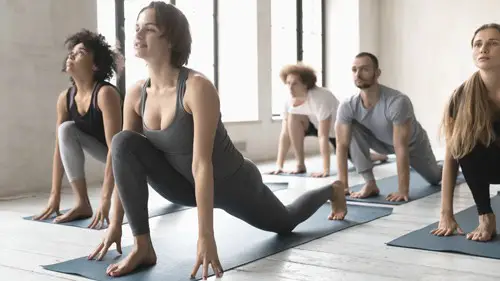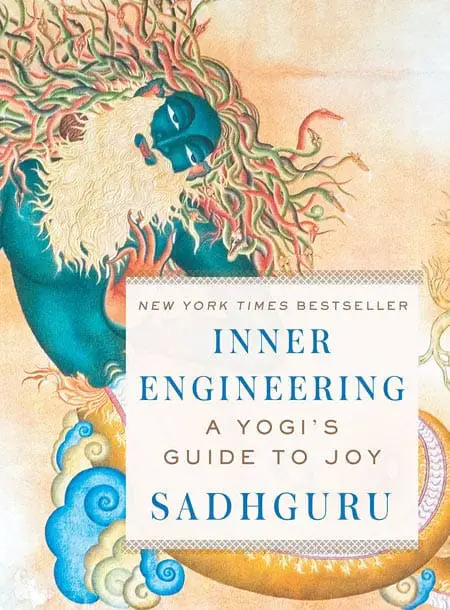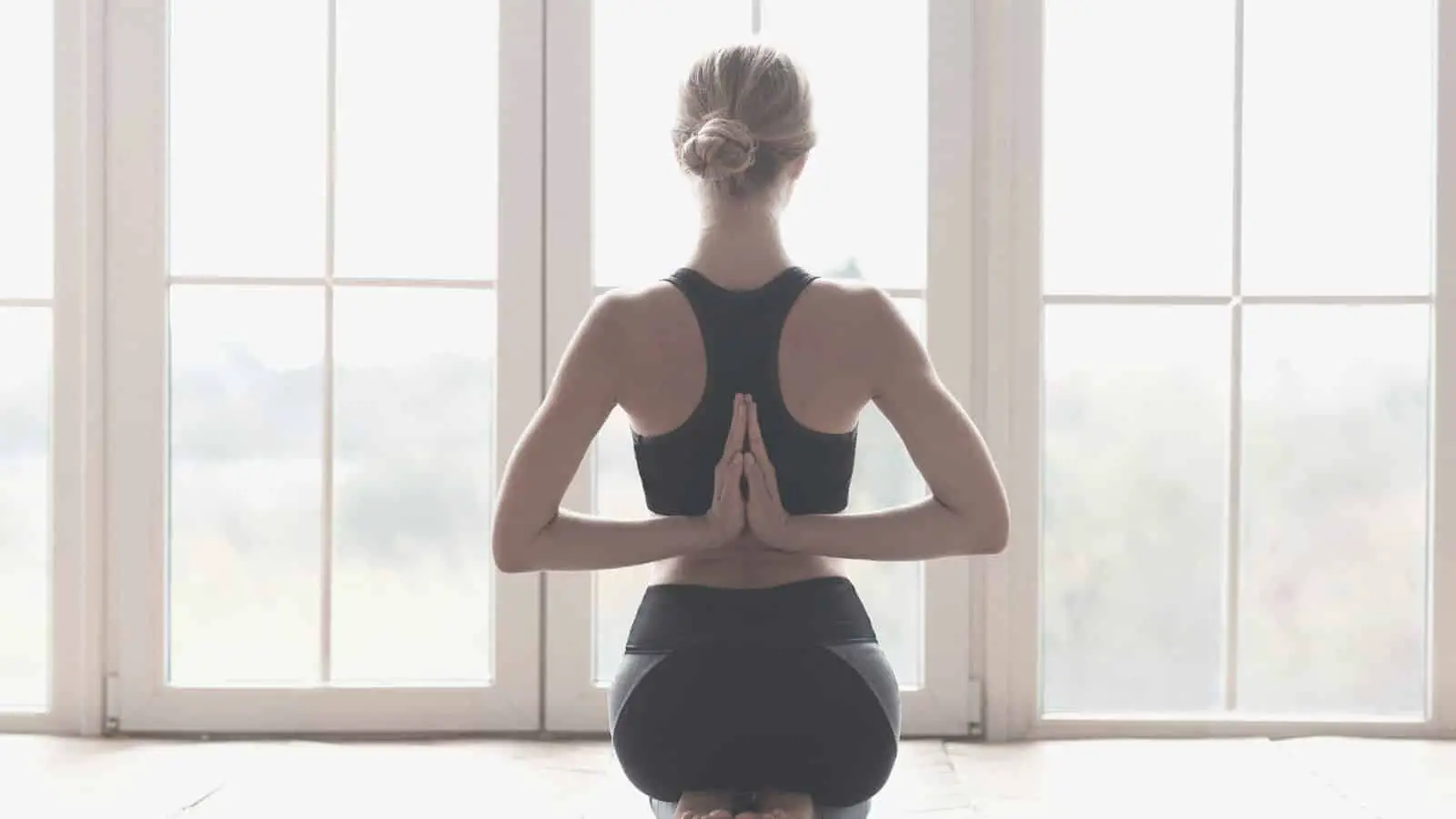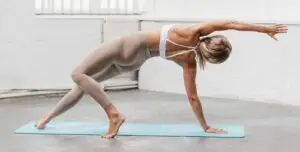There are many benefits to both yoga and meditation; while yoga improves flexibility and balance and calms the mind and body, meditation has been shown to reduce symptoms of depression and anxiety, among other health advantages. Yoga and meditation work well in conjunction, but which practice should you do first to reap the most benefit?
The timing of your meditation and yoga practice will depend on your goals. Traditionally, yogis did yoga before meditating to release energy and prepare the body for restful meditation. That being said, some yoga practices include meditation; in Yoga Nidra, for example, the goal is a trance-like, meditative sleep.
In the remainder of this article, we’ll discuss the benefits of both yoga and meditation and explore how you might structure your yoga and meditation practices to meet your goals.
Should I Meditate or Do Yoga First?

There are many benefits to both yoga and meditation. Both practices have been proven to reduce stress, improve athletic performance, memory, and sleep. But which method should you do first to reap the most benefits?
The timing of your meditation and yoga practice will depend on your goals. Many Buddhists do yoga to improve the quality, length, and comfort of their meditation sessions. Yoga can improve joint health and flexibility, making it easier to sit still for long periods while meditating. Yoga can also release energy in the body, making it easier to rest the mind during meditation.
For this reason, many people choose to do yoga before meditation to deepen their meditative practice.
Meditation is also a part of yogic practice. Many kinds of yoga focus on breathing and become a moving meditation. Still, other types of yoga involve deep meditation, like Yoga Nidra, where the goal is meditative sleep.
Yoga Poses for Improved Meditation Practice
If you choose to do yoga before your meditation practice, there are several poses that can improve your breathing and posture during meditation. These poses focus on opening the chest and lungs and releasing energy in the body so that the mind can quiet during meditation.
Salutation or Prayer Pose
Prayer pose is simple—it involves putting your hands in a prayer position while in a comfortable seat. Some people choose to meditate in this pose but practicing for only a few minutes before yoga. Meditation can help open the chest, shoulders and center your attention on the diaphragm for improved concentration.
Child’s Pose

Child’s pose allows you to stretch your entire body while in a relaxed posture. This pose involves sitting on your knees and then pulling your body over your legs, so your face presses into the mat or floor, and your arms stretch long in front of you.
This pose stretches your back, neck, hips, and shoulders, releasing tension to prepare the body for meditation while maintaining a low intensity.
Mountain Pose
In mountain pose, you stand straight with your hands open by your hips. This pose is great for steadying your breath and strengthening your body. It also allows energy to flow up through your body.
Low Lunge

Low lunges are familiar to athletes and runners. To do a low lunge, put one leg in front of you, one leg stretched behind, and bend your front knee to tighten the thighs and hips.
Low lunges stretch the hips and strengthen the legs, areas that both can become tight or uncomfortable during long seated meditations. For many people, the hips hold energy and tension, and releasing those muscles can improve clarity and comfort during meditation.
Tree Pose
Tree pose is a classic yoga pose that involves balance and concentration, as well as chest and hip opening. In tree pose, yogis stand on one foot and lift the second foot, resting it either on the ankle, above the knee, or tucked into the upper thigh. Balancing during this pose aligns with concentration during meditation, preparing your mind to focus.
Eagle Pose
The eagle pose is another balancing pose, but with a lot of twists. Eagle pose is relatively complicated to explain but essentially involves crossing both your arms and legs and bending your knees so you are folded into a deep knot.
Eagle is particularly good for opening the upper back and shoulders for improved breathing. Combined with the concentration from the balance and complicated twist, this pose will prepare you for any meditation.
Dancer Pose
Dancer is another balancing pose that stretches and elongates the body. In this pose, you stand on one leg and send one leg long behind you, balancing your opposite arm toward the front of your mat. The balance will help you hone your focus, and lengthening your body will release energy through your head and feet to calm your mind during meditation.
Camel Pose

In camel pose, the yogi begins by sitting on their knees, and then places the arms behind their feet and lifts the chest toward the sky. Camel pose opens the chest and allows energy to escape from the head that may be trapped in the lower body. This deep chest stretch is excellent for improved breathing, back and side flexibility and posture.
Corpse Pose
Though corpse pose might not seem important, it is—laying on your mat after a yoga practice is known to settle the mind and body and allow your muscles to relax after intensive stretching. You can also use the corpse pose as a meditation pose itself and dive right into your meditation immediately after finishing your yoga practice.
Types of Meditation You Can Practice During Yoga
There are a variety of types of yoga that involve meditative practices. You can incorporate different kinds of meditation into your yoga practice. Below is a list of meditation practices (type and description) that complement yoga and might be included within your yoga flow:
Pranayama: Breathwork is one of the eight limbs of yoga. There are several techniques implemented in pranayama meditation. Benefits of incorporating controlled breathing in yoga and meditation include: calming your nervous system, promoting focus and relaxation, and relieving stress.
Kundalini Meditation: This form of meditation is practiced in Kundalini Yoga. This meditation utilizes breath, position, and mindfulness to move energy through the body from the spine’s base.
Transcendental Meditation: This form of meditation was developed by Maharishi Mahesh Yogi and is a practice of daily mantra meditation.
Yoga Nidra: Yoga Nidra, or yogic sleep, is a practice that involves using guided meditation to fall into a state of consciousness between sleep and waking. Yoga Nidra has been shown to reduce stress and improve mental and physical well-being.
Yogic Knots and How They Impact Meditation
In Kundalini yoga, there are three psychic knots, or grantis, that are obstacles in the path to enlightenment. The grantis are in your hips, chest, and head, and represent different struggles you might experience as a yogi.
Grantis can also hinder your meditation practice because they are psychic, or mental blocks; these struggles speak to the joint path toward enlightenment through yoga and meditation.
The principle of Kundalini yoga is that yogic practices allow you to awaken a life force within your body. Awakening the Kundalini means allowing it to pass through each chakra into the third eye, or consciousness.
Grantis get in the way of your life force’s passage through each chakra. Doing yoga can help the force move through these knots to great deeper mindfulness and greater mental clarity and power.

The three grantis are Brahma, Vishnu, and Rudra. Each symbolizes an attachment.
- Brahma, located in the hips, is attachment to the material world,
- Vishnu, located in the chest or heart, is about emotional attachment, and
- Rudra, in the mind, is the attachment to our idea of the self as an individual.
The principle behind doing yoga before meditation for many yogis and meditation experts is that yoga can release the psychic knots of energy in the body that may limit the mind from awakening the internal life force.
Yoga allows the body to physically unknot the grantis, and meditation solidifies the movement of life force toward the mind’s eye.
Health Benefits of Pairing Yoga and Meditation
Meditation and yoga offer complementary health benefits, including:
Stress Reduction
A study conducted by The University of Sussex School of Psychology found that meditators experienced reduced stress levels even when faced with conflict. This study and countless years of psychological research have confirmed that daily meditation has the power to reduce stress and improve the nervous system’s response to stressful stimuli.
Similarly, yoga has been shown to reduce cortisol levels in the body. In one study, 24 women who identified as emotionally distressed had significantly lower cortisol levels after three months of daily yoga.
Reduces Anxiety and Depression
Along with stress reduction, several studies have been done with psychologists on the impact of meditation and yoga on patients struggling with anxiety and/or depression. In studies done on patients with PTSD, regular yoga classes only a few times a week caused up to a 52% reduction in PTSD symptoms.
Both meditation and yoga are known to reduce cortisol levels, which impact serotonin levels in the brain; serotonin has a direct impact on symptoms of anxiety and depression.
Certain kinds of meditation also create pathways in the brain linked to gratitude and optimism, which can reduce symptoms of depression and make lingering symptoms more manageable for patients.
Improved Sleep
Meditating and practicing yoga can not only improve your waking life, but it can also affect your ability to fall and stay asleep.
A study conducted by the Department of Preventative Medicine at the University of Southern California found that daily meditation was an effective treatment for insomnia and sleep disturbances. In a study done on a group of senior citizens, yoga offered better sleep benefits than an herbal remedy or the control group. Participants who did yoga reported staying asleep longer and falling asleep faster than their counterparts.
Sleep plays an essential role in our body’s ability to function and repair itself, and improving your quality of sleep can have numerous benefits for your overall health.
Improved Physical Health and Ability
According to the Journal of Cognitive Enhancement, meditation improves athletic performance for both closed and open skilled sports.
Closed skill sports are typically sports where the environment is fixed, such as track and field or gymnastics. Open skilled sports generally are team sports where competitors can change the setting, including basketball or soccer.
Different forms of meditation have been proven to affect athletic performance in different ways. If your goals include improving your speed, agility, or skill, meditation may offer a competitive edge.
Similarly, yoga can offer benefits for physical health and ability, including increased flexibility and balance, which can improve agility and speed in athletes. Yoga can also help with muscle recovery.
What If I Struggle to Meditate?
If you struggle to focus during meditation or have trouble keeping a daily meditation practice, many people enjoy combining meditation with spiritual reading. Like a morning devotion, many gurus recommend daily spiritual reading.
This practice is easy because you can select any text that suits your growth and development. For this method, each day, you would read a section of spiritual text and then meditate on/integrate what you have learned from the section.

A few books that may be beneficial to your daily rituals may include:
- Inner Engineering: A Yogi’s Guide to Joy by Sadhguru
- Stumbling Into Infinity: An Ordinary Man in the Sphere of Enlightenment
- The Heart of Yoga: Developing a Personal Practice by TKV Desikachar
- Strength in Stillness: The Power of Transcendental Meditation by Bob Roth
- The Yoga of Breath: A Step-by-Step Guide to Pranayama
- Polishing the Mirror: How to Live from Your Spiritual Heart by Ram Dass
- Kundalini Yoga: The Flow of Eternal Power: A Simple Guide to the Yoga of Awareness as taught by Yogi Bhajan Ph.D
How Do I Choose a Yoga and Meditation Practice to Fit My Lifestyle?
While most experts recommend the traditional method of doing yoga before meditating, there are other considerations, including schedule and lifestyle, that might influence your mindfulness practice.
When you meditate and do yoga, whether you seek calm or energy, and the type of yoga or meditation you want to do, can influence your process and practice.
Morning vs. Evening Practice
Many people choose to practice yoga and meditation either first thing in the morning or in the evening before sleep. Both of these options have benefits and can influence the kind of practices you choose.
Evening practitioners might choose a calming yoga practice with deep stretches, like yin yoga. These deep stretches allow for the release of tension and energy from the body and can be coupled with guided meditations for sleep, Yoga Nidra, or similar practices.
On the other hand, morning yogis might choose an invigorating or energizing practice to start the day. For some people, it makes sense to begin this practice with meditation to clear the mind after a night of sleep and build energy through yoga practice. If you want to practice meditation after your morning yoga, you can also choose a more energizing meditation, like a walking meditation.
Choosing Your Priorities
When it comes to developing your practice, you have to choose your priorities and consider the benefits that most interest you.
If you are seeking spiritual enlightenment, you might choose the way of traditional yogis, who did yoga before meditation to prepare the mind by releasing psychic knots, tension, and pent up energy.
If you want to see the mental and emotional health benefits of yoga and meditation, you might choose a calming evening practice to reduce anxiety, or an invigorating morning practice to alleviate symptoms of depression and boost your mood.
Yoga and meditation practices are also helpful for those struggling with chronic pain. For those practitioners, it might make sense to have a daily routine in the morning or evening, depending on your energy levels, and supplement with short practices during the day to manage chronic pain, inflammation, and discomfort.
Final Thoughts: The Link Between Yoga and Meditation
Yoga or meditation alone have been proven to improve health and well-being, but you will notice the most significant results by developing a daily practice that includes both activities. Deciding whether to meditate before or after your yoga session will depend on your goals, but many experts in meditation recommend yoga before your practice to improve concentration and lengthen your practice.
Yoga and meditation are linked, not only in the benefits they offer but also in their practice philosophies. Breathwork is an integral part of yoga and meditation. Many yoga practices include meditation; for example, the shavasana pose at the end of traditional yoga practices often consists of a brief guided meditation.
Ultimately, your yoga and meditation practice are your own, and you should develop them over time. For many people, doing yoga before meditation offers the most benefit, but creating the right method for you is all about experimenting and reflecting on what you want from your practice.





